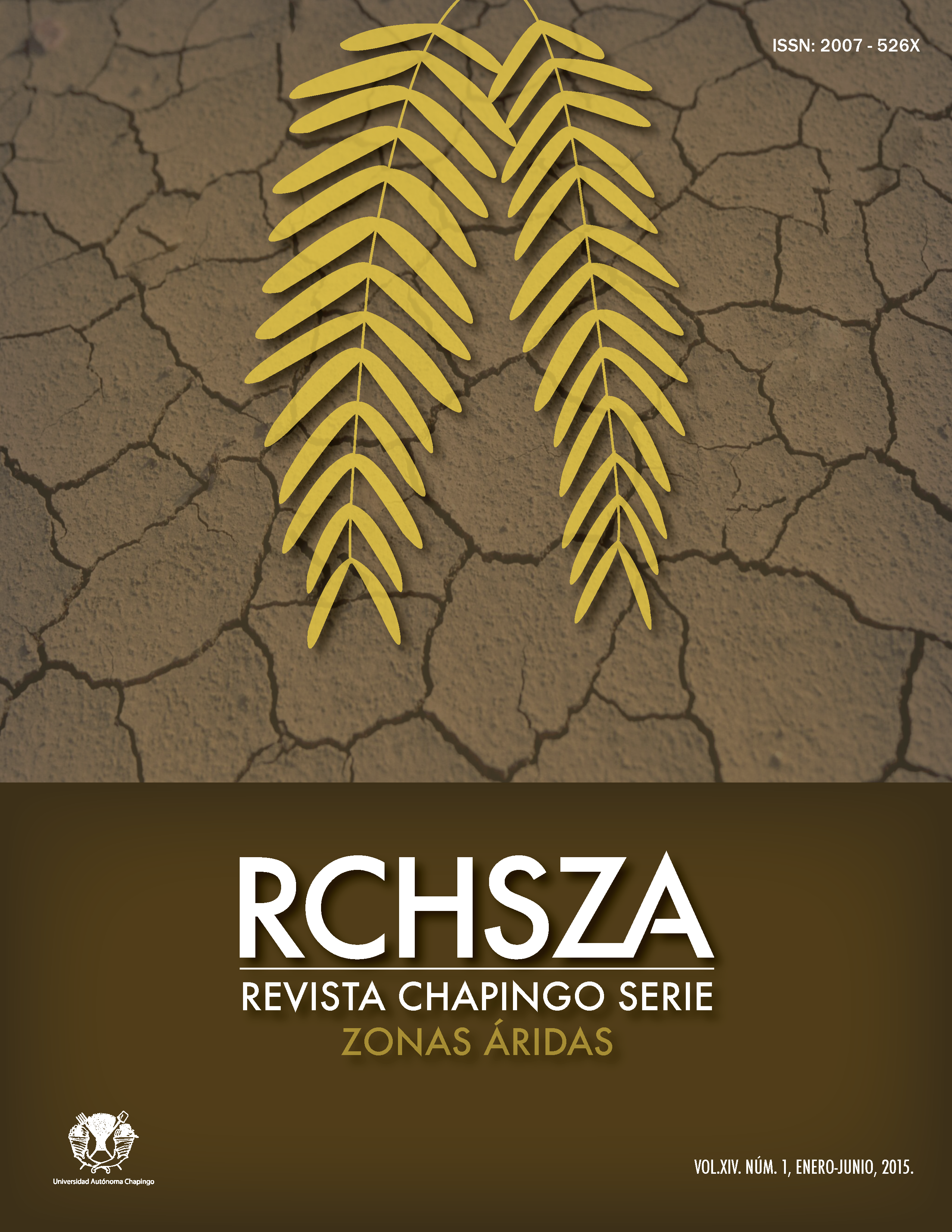Abstract
The low and erratic rainfall in rainfed areas in Mexico, categorizes the production systems in these areas as high risk. This leads to the need for improved agricultural planning in order to increase productivity of rainfall. In this study, we proposed a method to characterize crop sensitivity to water stress and its impact on crop’s yield. The method uses functions of water stress index (WSI) based on water balance (Pp – Et0) from where crop sensitivity (λ) and the impact on relative yield it is deduced. We found that maize is the crop with the less sensitivity to water stress in all its stages of development; on the other hand, beans shows an evident sensitivity in all its stages of development. For all the crops analyzed, the stage of development shows the highest sensitivity to water deficit. In addition, we found the accumulative effect to water stress in all the stages of crop development. We consider that the method may be useful in the planning process of impact amelioration.
References
Allen Richard G.; Luis S. Pereira; Dirk Raes; Smith Martin. 1988. FAO Irrigation and Drainage Paper No. 56 Crop Evapotranspiration (guidelines for computing crop water requirements). FAO. Rome, Italy. pp 174.
Blaney, H. F.; Criddle, W. D. 1950, Determining Water Requirements in Irrigated Area from Climatological Irrigation Data, US Department of Agriculture, Soil Conservation Service, Tech. Pap. No. 96, pp. 48
Blaney, H. F.; Criddle, W. D. 1962. Determining consumptive use and irrigation water requirements. No. 1275. Technical Bulletin. USDA. Estados Unidos. pp 59
Bootsma, A.; Boisvert, J.; Dumanski, J. 1994. Climate-Based Estimates of Potential Forage Yields in Canada Using a Crop Growth Model. Agricultural and Forest Meteorology, 67, 151-172. http://dx.doi.org/10.1016/0168-1923(94)90001-9
Brouwer, C.; Heibloem, M. 1986. Irrigation water management: Irrigation water needs. FAO. Roma, Italia. [En línea] Disponible para la World Wide Web en: http://www.fao.org/docrep/S2022E/S2022E00.htm
Díaz Padilla G.; Panes Rafael, G.; Medina García, G.; Sánchez Cohen, I.; Soria Ruiz, J.; Vásquez Alvarado, J. M.; Quijano Carranza, J. A.; Legorreta Padilla, F.; Ruiz Corral, A. 2012. Potencial productivo de especies agrícolas de importancia socioeconómica en México. INIFAP. Publicación especial No. 8. 137 pp.
Doorembos, J.; Kassam A. H. 1979. Yield Response to Water. FAO Irrigation and Drainage Paper No. 33, FAO, Rome, 193.
Hauviller, A. P.; Días, H.; Pérez, D.; Rodríguez L., M. 2006. Un aporte a la estimación de la evapotranspiración del cultivo juvenil de Arnadano utilizando metodología según FAO en localidades de la Mesopotamia Argentina. INTA. pág [en línea] Disponible para la World Wide Web en: http://www.inta.gov.ar/mendoza/jornadas/Trabajospresentados/Hauviller.pdf
Jensen, M. E. 1968. Water consumption by agricultural plants. Chap.1 in Water Deficits and Plant Growth, Vol II, T. T. Kozlowski, ed., Academic Press, New York., pp. 1-22.
Kipkorir, E. C.; Raes, D. 2002. Transformation of yield response factor into Jensen’s sensitivity index. Irrigation and Drainage Systems 16: 47 – 52
Leuven, K. U. 2002. Budget: a Soil Water and Salt Balance Model. Reference Manual. Faculty of Agricultural and Applied Biological Sciences Institute for Land and Water Management. Belgium. Pp 79
Oweis, T.; Hachum, A.; Kijne, J. 1999. Water harvesting and supplementary irrigation for improved water use efficiency in dry areas. SWIM Paper 7. Colombo, Sri Lanka: International Water Management Institute
Sánchez Cohen I. 2005. Manejo Integral del Agua en Cuencas Hidrológicas. Una Aproximación de Simulación de Procesos. Libro Científico No.2. INIFAP CENID RASPA. Pp 272.
Sánchez Cohen, I.; Velasquez Valle, M. A.; Catalán Valencia, E. A.; Inzunza Ibarra, M. A.; Esquivel Arriaga, G.; Bueno Hurtado, P.; Díaz Padilla, G. 2013. Modelo de balance hídrico como apoyo a toma de decisiones en zonas agrícolas bajo incertidumbre climática. Folleto Técnico No. 28. INIFAP CENID RASPA. pp 53.
Sánchez Cohen I.; Esquivel Arriaga, G.; Velásquez Valle, M. A.; Inzunza Ibarra, Marco A.; Muñoz Villalobos, Arcadio; Bueno Hurtado, P. 2014. Climate Based Risk Assessment for Maize Producing Areas in Rainfed Agriculture in Mexico. Journal of Water Resources and Protection. Vol. 6, 1228-1237.
Sánchez-Cohen, I.; Díaz-Padilla, G.; Velásquez-Valle, M.; Slack, D. C.; Heilman, P.; Pedroza-Sandoval, A. 2015. A decision support system for rainfed agricultural areas of Mexico. Computers and Electronics in Agriculture 114 (2015) 178–188.
Sánchez Tienda, J. 1999. Uso consuntivo del cultivo del aguacate: Metodología Blaney y Criddle modificada relacionando fenología y precipitación. Revista Chapingo Serie Horticultura 5:201-207
Servicio de Información Agroalimentaria y Pesquera (SIAP). 2014. Consultado el 09-09-2014 en http://www.siap.gob.mx/Smith M.; Pasquale Steduto. 2006. Yield response to water: the original FAO water production function. FAO. Rome Italy. Pp 13.
Stephen, John C.; Stewart, Ernest H. 1963. A comparison of procedures for computing evaporation and evapotranspiration. IAHS. Bélgica. Pp.11. [en línea] Disponible en la World Wide Web en: http://iahs.info/redbooks/a062/iahs_062_0123.pdf
Tsakiris, G. P. 1982. A method for applying crop sensitivity factors in irrigation scheduling. Agric. Water Manage. 5: 335-343.
Xu, C. Y.; Singh, V. P. 2002. Cross comparison of empirical equations for calculating potential evapotranspiration with data from Switzerland. Water resources Management 16: 197-219.

This work is licensed under a Creative Commons Attribution-NonCommercial 4.0 International License.
Copyright (c) 2015 Revista Chapingo Serie Zonas Áridas




